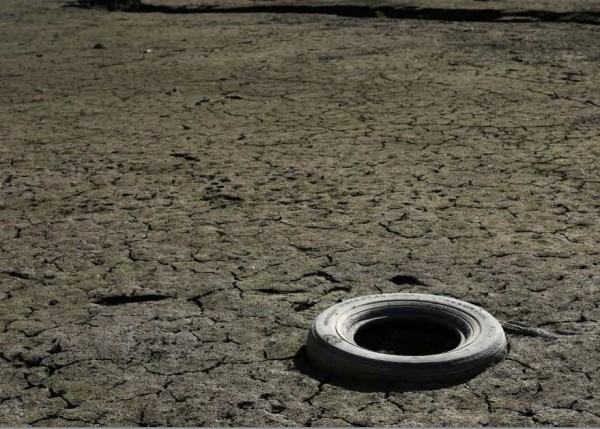Unimaginable 'Megadrought' Threatens U.S. by 2050
| Marco Foronda | | Feb 13, 2015 03:06 AM EST |
(Photo : Reuters) An automobile tire is shown at the bottom of the Almaden Reservoir near San Jose, California.
Researchers claim global warming will bring the "unprecedented" risk of a decades-long megadrought in the American Southwest and Great Plains during the second half of the century.
This destructive megadrought is likely to hit by 2050 and stick around because of global warming.
Like Us on Facebook
"Nearly every year is going to be dry toward the end of the 21st century compared to what we think of as normal conditions now. We're going to have to think about a much drier future in western North America," said study lead author Benjamin Cook, NASA atmospheric scientist.
NASA researchers used historic tree ring data and three drought measures to conclude there is at least an 80 percent chance of a 35 year long drought occurring by the end of this century.
The regions Cook looked at include California, Nevada, Utah, Oklahoma, Colorado, New Mexico, Arizona, northern Texas, South Dakota, Kansas, Nebraska, most of Iowa, southern Minnesota, western Missouri, western Arkansas, and northwestern Louisiana.
Cook and his co-authors, Toby Ault, a geoscientist at Cornell University, and climate scientist at Lamont-Doherty Earth Observatory of Columbia University Jason Smerdon, said human-produced greenhouse gasses were increasing the likelihood of future droughts.
They added that higher temperatures, low precipitation and increased rates of evaporation would result in drier soils. Their model was based on predicted emissions, and that reductions in those emissions could mitigate future drying.
Paleoclimatic evidence gathered suggests intense periods of dryness occurred in this region from the 9th to the 14th centuries, a period now called the Medieval Climate Anomaly.
They also said this future megadrought will probably exceed that of the Medieval Anomaly.
The new study was published in the journal, Science Advances.
TagsMegadrought, global warming, NASA, drought, El Nino
©2015 Chinatopix All rights reserved. Do not reproduce without permission
EDITOR'S PICKS
-

Did the Trump administration just announce plans for a trade war with ‘hostile’ China and Russia?
-

US Senate passes Taiwan travel bill slammed by China
-

As Yan Sihong’s family grieves, here are other Chinese students who went missing abroad. Some have never been found
-

Beijing blasts Western critics who ‘smear China’ with the term sharp power
-

China Envoy Seeks to Defuse Tensions With U.S. as a Trade War Brews
-

Singapore's Deputy PM Provides Bitcoin Vote of Confidence Amid China's Blanket Bans
-

China warns investors over risks in overseas virtual currency trading
-

Chinese government most trustworthy: survey
-

Kashima Antlers On Course For Back-To-Back Titles
MOST POPULAR
LATEST NEWS
Zhou Yongkang: China's Former Security Chief Sentenced to Life in Prison

China's former Chief of the Ministry of Public Security, Zhou Yongkang, has been given a life sentence after he was found guilty of abusing his office, bribery and deliberately ... Full Article
TRENDING STORY

China Pork Prices Expected to Stabilize As The Supplies Recover

Elephone P9000 Smartphone is now on Sale on Amazon India

There's a Big Chance Cliffhangers Won't Still Be Resolved When Grey's Anatomy Season 13 Returns

Supreme Court Ruled on Samsung vs Apple Dispute for Patent Infringement

Microsoft Surface Pro 5 Rumors and Release Date: What is the Latest?










